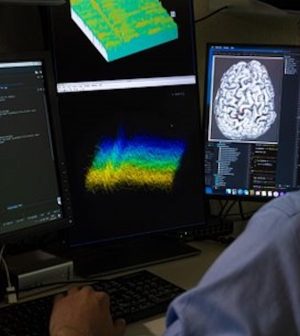- Navigating Your Midlife Crisis: Embracing New Possibilities
- City Raccoons Showing Signs of Domestication
- Mapping the Exposome: Science Broadens Focus to Environmental Disease Triggers
- One Week Less on Social Media Linked to Better Mental Health
- Your Brain Changes in Stages as You Age, Study Finds
- Some Suicide Victims Show No Typical Warning Signs, Study Finds
- ByHeart Formula Faces Lawsuits After Babies Sickened With Botulism
- Switch to Vegan Diet Could Cut Your Greenhouse Gas Emissions in Half
- Regular Bedtime Does Wonders for Blood Pressure
- Dining Alone Could Mean Worse Nutrition for Seniors
Brain Implant Helps Completely ‘Locked-In’ Man Communicate

Unable to move a single muscle, even to open your eyes. Completely locked into your own body, yet fully conscious and aware.
Lou Gehrig’s disease — amyotrophic lateral sclerosis (ALS) — is a nightmare in its advanced form, leaving patients without any means of communicating their needs and wishes.
But a new brain implant has allowed a 34-year-old locked-in ALS patient to regain his ability to communicate with family and doctors, European researchers say.
Two microchip implants inserted into the brain of the German patient allow him to form words and even full sentences, using nothing but mental impulses.
“It shows that you can write sentences with the brain even if you are completely paralyzed without any eye movement or other muscles to communicate,” said lead researcher Niels Birbaumer. He is director of the Institute of Medical Psychology and Behavioral Neurobiology at the University of Tubingen, in Germany.
This new brain-computer interface will allow a completely locked-in patient to say “whatever they want,” Birbaumer added.
The patient was diagnosed in August 2015 with a fast-progressing form of ALS, the study authors said in background notes.
By the end of 2015, he’d lost the ability to talk and walk. The next year he was placed on a ventilator, because he couldn’t move his muscles to draw breath.
At first, the man could communicate using an eye-tracking device, which used his eye movements to put together words and sentences.
“In the ALS community, we typically think of people who are locked-in as being unable to move their body with the exception of their eyes,” said Neil Thakur, chief mission officer for the ALS Association. “Some people with ALS are very proficient at using their eyes to communicate at a very high level with the help of assistive technology, such as eye-gaze machines.”
By August of 2017, the German man couldn’t even do that, because he lost the ability to fix his gaze.
The man’s family gave permission to have two implants, each a little more than a tenth of an inch square, placed inside his motor cortex — the part of the brain responsible for movement. Each implant has 64 needle-like electrodes that detect neural signals.
The man learned to generate brain activity by telling his body to move, even though it no longer can. The implants pick up that brain activity and feed it into a computer as a “yes/no” signal.
A spelling program reads the letters of the alphabet aloud, and the man selects specific letters using his brain waves.
The process is slow — about one letter a minute — but has allowed the patient to regain some communication with those around him.
“This study demonstrates the promise and tragedy of ALS,” said Thakur, who was not involved with the research. “We know people who are locked-in can maintain their mental functioning, and continue to have meaningful emotional connections with their families.”
Unfortunately, the technology involved in this brain-computer interface is still very expensive, and requires much time and dedication, said co-researcher Jonas Zimmermann, a senior neuroscientist with the Wyss Center for Bio and Neuroengineering in Geneva, Switzerland.
For example, caregivers must be trained to set up the system and validate the patient’s responses, so the person can effectively communicate using the brain implant, he said.
“At the Wyss Center, we are developing a fully implantable device which will reduce the risk of infection, and will be easier to set up and control,” Zimmermann said. “The system is currently in pre-clinical verification. We plan clinical trials in the near future.”
That wireless device, named ABILITY, could enable speech decoding directly from the brain as the patient imagines speaking, leading to more natural communication, Zimmermann said.
The new study was published online March 22 in the journal Nature Communications.
More information
The ALS Association has more about amyotrophic lateral sclerosis.
SOURCES: Niels Birbaumer, PhD, director, Institute of Medical Psychology and Behavioral Neurobiology, University of Tubingen, Germany; Jonas Zimmermann, PhD, senior neuroscientist, Wyss Center for Bio and Neuroengineering, Geneva, Switzerland; Neil Thakur, PhD, chief mission officer, ALS Association, Arlington, Va.; Nature Communications, March 22, 2022, online
Source: HealthDay
Copyright © 2025 HealthDay. All rights reserved.










